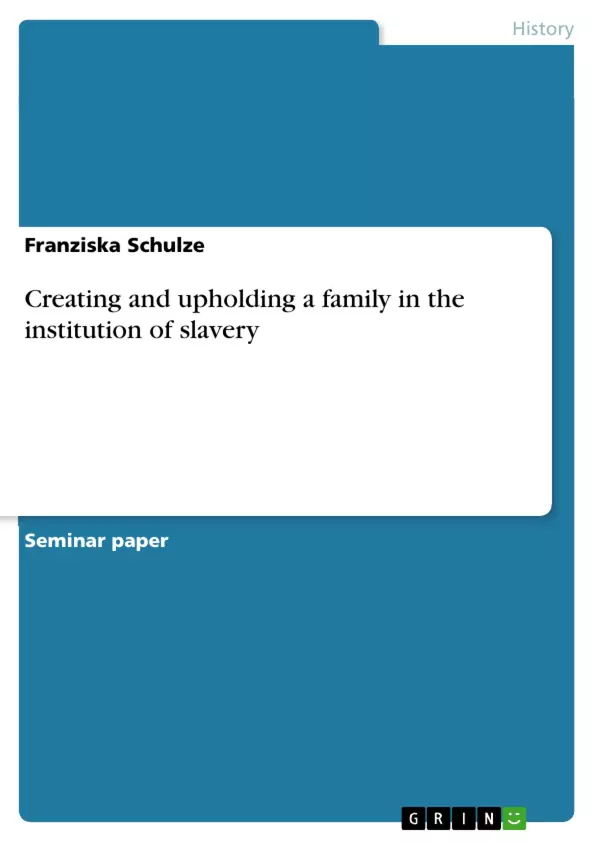In an encyclopedia the term family is defined as “a fundamental social group in society consisting of one or two parents and their children,” and “all the members of a household under one roof.” Many more definitions have evolved over time through social changes in different societies and have been focused on in cultural studies. In times of slavery in the U.S. blacks had to cope with their living conditions and in that still had the urge to create families. This often was made impossible right from the start because “[l]arge owners often refused to allow marriage[. . .].” Rarely, if ever, the family of slaves could be described as nuclear – father, mother and child. The cause for the lack of a family was easily found. Eugene Genovese explains: “[M]any masters did not respect their slaves’ family feelings and did not hesitate to sell them as individuals.” The physical separation or the fear of such made it difficult to built a loving family. Within the system of slavery, “[. . .] the mother role took on a stronger image,” states Staples. The father figure never withheld great importance within the family structure for various reasons. One of them is that the status of a child always got defined by the status of his or her mother. Children are being influenced during every day of their lives by their parents or the lack thereof. Connected to Alice Randall’s parody “The Wind Done Gone” my analysis will focus on what factors constituted issues in constructing a family for house slaves. I want to point out the difficulties especially women experienced when trying to build a family, and how they influenced the mother-daughter relationship. What mark did they leave on the daughter’s future and how did she cope with the problems of creating a family of her own? Particularly for mulattoes, I am interested in if and how the race itself caused issues that needed to be overcome.
Inhaltsverzeichnis (Table of Contents)
- Introduction
- The Woman - Her Lives
- Her duties - Concubine, Slave, Servant: Helping or Hindering
- Mammy and Mother - Privilege or Curse
- The Mulatto Offspring
- Part of the Institution of Slavery or a Family
- Adult Life - The Wish, The Hindrances, Her Color
- Conclusion
Zielsetzung und Themenschwerpunkte (Objectives and Key Themes)
This analysis delves into the complexities of family formation within the institution of slavery in the U.S., focusing on the obstacles faced by enslaved women and their mulatto offspring. It investigates the impact of slavery on the mother-daughter relationship and examines the challenges of building a family despite the constraints of racial prejudice and the institution itself.
- The impact of the institution of slavery on family formation for enslaved women
- The role and challenges of the "Mammy" figure
- The impact of racial prejudice on mulatto offspring and their ability to build a family
- The influence of the mother-daughter relationship in the context of slavery
- The complexities of forming a family in the face of systemic oppression
Zusammenfassung der Kapitel (Chapter Summaries)
The introduction explores the concept of family in the context of slavery, highlighting the challenges faced by enslaved individuals in establishing and maintaining family units. It lays out the analysis's focus on the experiences of enslaved women and their mulatto daughters, particularly within the context of house slavery.
The first chapter delves into the various roles and duties of enslaved women, including their roles as concubines, slaves, and servants. It examines how these roles impacted their ability to build and maintain families, highlighting the challenges of balancing their duties with the demands of motherhood.
The second chapter investigates the complex role of the "Mammy" figure on plantations. It analyzes the privileges and drawbacks of this position, exploring how it influenced the ability of Mammies to protect their own families and the complexities of their dedication to both their own children and the white children they cared for.
Schlüsselwörter (Keywords)
The primary focus of this analysis is on the concepts of family, race, and gender within the context of slavery. It explores themes such as the institution of slavery, house slavery, the Mammy figure, mulatto offspring, interracial relationships, mother-daughter relationships, and the challenges of building a family in the face of systemic oppression.
- Citation du texte
- Franziska Schulze (Auteur), 2011, Creating and upholding a family in the institution of slavery, Munich, GRIN Verlag, https://www.grin.com/document/274188



